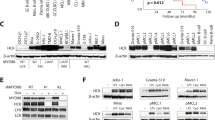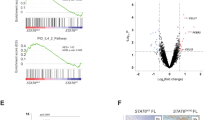Abstract
We have previously reported an overexpression of Smad1 in follicular lymphoma (FL) cells, which are characterized by the t(14;18) bcl2/IgH translocation. Smad1 is commonly involved in bone morphogenetic protein but not in tumor-transforming growth factor beta (TGFβ) signaling pathways. This study focuses on Smad1 signaling pathway in non-Hodgkin lymphoma cells including follicular or large-cell lymphoma cells. Our results support the notion that phosphorylation of Smad1 is mediated by TGFβ present in the microenvironment and occurs in FL in vivo. Using an in vitro coculture system mimicking interactions between stroma cells and FL cells, we found that both the cell partners release TGFβ at a sufficient concentration to activate Smad pathways in the malignant cells. This Smad1 activation involves TGFβRII but not ALK-1 receptors, and does not compete with the Smad2 pathway. Moreover, proliferation assays performed on lymphoma cells expressing wild-type or mutated Smad1, or in which endogenous Smad1 level was decreased by gene silencing, strongly supported that overexpression and activation of Smad1 modifies the biological response of lymphoma B cells to TGFβ family members. This work opens new insights into aberrant Smad pathways and their pathophysiological role in FL and in other non-Hodgkin lymphomas.
This is a preview of subscription content, access via your institution
Access options
Subscribe to this journal
Receive 12 print issues and online access
$259.00 per year
only $21.58 per issue
Buy this article
- Purchase on Springer Link
- Instant access to full article PDF
Prices may be subject to local taxes which are calculated during checkout






Similar content being viewed by others
References
Jaffe ES, Shevach EM, Frank MM, Berard CW, Green I . Nodular lymphoma – evidence for origin from follicular B lymphocytes. N Engl J Med 1974; 290: 813–819.
Hockenbery DM, Oltvai ZN, Yin X-M, Milliman CL, Korsmeyer SJ . Bcl-2 functions in an antioxidant pathway to prevent apoptosis. Cell 1993; 75: 241–251.
Tsujimoto Y, Cossman J, Jaffe E, Croce C . Involvement of bcl-2 gene in human follicular lymphoma. Science 1985; 228: 1440–1443.
Husson H, Carideo EG, Neuberg D, Schultze J, Munoz O, Marks PW et al. Gene expression profiling of follicular lymphoma and normal germinal center B cells using cDNA arrays. Blood 2002; 99: 282–289.
Braylan RC, Benson NA, Nourse VA . Cellular DNA of human neoplastic B-cells measured by flow cytometry. Cancer Res 1984; 44: 5010–5016.
Srigley J, Barlogie B, Butler JJ, Osborne B, Blick M, Johnston D et al. Heterogeneity of non-Hodgkin's lymphoma probed by nucleic acid cytometry. Blood 1985; 65: 1090–1096.
Naiem M, Gerdes J, Abdulaziz Z, Stein H, Mason DY . Production of a monoclonal antibody reactive with human dendritic reticulum cells and its use in the immunohistological analysis of lymphoid tissue. J Clin Pathol 1983; 36: 167–175.
Yamada K, Yamakawa M, Imai Y, Tsukamoto M . Expression of cytokine receptors on follicular dendritic cells. Blood 1997; 90: 4832–4841.
Umetsu DT, Esserman L, Donlon TA, DeKruyff RH, Levy R . Induction of proliferation of human follicular (B type) lymphoma cells by cognate interaction with CD4+ T cell clones. J Immunol 1990; 144: 2550–2557.
Ghia P, Caligaris-Cappio F . The indispensable role of microenvironment in the natural history of low-grade B-cell neoplasms. Adv Cancer Res 2000; 79: 157–173.
Massague J . TGF-beta signal transduction. Annu Rev Biochem 1998; 67: 753–791.
Lebman DA, Edmiston JS . The role of TGF-beta in growth, differentiation, and maturation of B lymphocytes. Microbes Infect 1999; 1: 1297–1304.
Golstein P, Wyllie AH . T cell death and transforming growth factor beta1. J Exp Med 2001; 194: F19–F22.
Piek E, Heldin CH, Ten Dijke P . Specificity, diversity, and regulation in TGF-beta superfamily signaling. FASEB J 1999; 13: 2105–2124.
Kingsley DM . The TGF-beta superfamily: new members, new receptors, and new genetic tests of function in different organisms. Genes Dev 1994; 8: 133–146.
Hogan BL . Bone morphogenetic proteins: multifunctional regulators of vertebrate development. Genes Dev 1996; 10: 1580–1594.
Ishisaki A, Yamato K, Hashimoto S, Nakao A, Tamaki K, Nonaka K et al. Differential inhibition of Smad6 and Smad7 on bone morphogenetic protein- and activin-mediated growth arrest and apoptosis in B cells. J Biol Chem 1999; 274: 13637–13642.
Hager-Theodorides AL, Outram SV, Shah DK, Sacedon R, Shrimpton RE, Vicente A et al. Bone morphogenetic protein 2/4 signaling regulates early thymocyte differentiation. J Immunol 2002; 169: 5496–5504.
Franitza S, Kollet O, Brill A, Vaday GG, Petit I, Lapidot T et al. TGF-beta1 enhances SDF-1alpha-induced chemotaxis and homing of naive T cells by up-regulating CXCR4 expression and downstream cytoskeletal effector molecules. Eur J Immunol 2002; 32: 193–202.
Tudor KS, Hess KL, Cook-Mills JM . Cytokines modulate endothelial cell intracellular signal transduction required for VCAM-1-dependent lymphocyte transendothelial migration. Cytokine 2001; 15: 196–211.
Lai CF, Feng X, Nishimura R, Teitelbaum SL, Avioli LV, Ross FP et al. Transforming growth factor-beta up-regulates the beta 5 integrin subunit expression via Sp1 and Smad signaling. J Biol Chem 2000; 275: 36400–36406.
Derynck R, Zhang Y . Smad-dependent and Smad-independent pathways in TGF-family signalling. Nature 2003; 425: 577–584.
Attisano L, Tuen Lee-Hoeflich S . The smads. Genome Biol 2001; 2(8): 3010.1–3010.8.
Hoodless PA, Haerry T, Abdollah S, Stapleton M, O'Connor MB, Attisano L et al. MADR1, a MAD-related protein that functions in BMP2 signaling pathways. Cell 1996; 85: 489–500.
Liu F, Hata A, Baker JC, Doody J, Carcamo J, Harland RM et al. A human Mad protein acting as a BMP-regulated transcriptional activator. Nature 1996; 381: 620–623.
Nakao A, Roijer E, Imamura T, Souchelnytskyi S, Stenman G, Heldin CH et al. Identification of Smad2, a human Mad-related protein in the transforming growth factor beta signaling pathway. J Biol Chem 1997; 272: 2896–2900.
Attisano L, Wrana JL . Signal transduction by the TGF-beta superfamily. Science 2002; 296: 1646–1647.
Yue J, Frey RS, Mulder KM . Cross-talk between the Smad1 and Ras/MEK signaling pathways for TGFbeta. Oncogene 1999; 18: 2033–2037.
Goumans MJ, Valdimarsdottir G, Itoh S, Rosendahl A, Sideras P, ten Dijke P . Balancing the activation state of the endothelium via two distinct TGF-beta type I receptors. EMBO J 2002; 21: 1743–1753.
Matsuyama S, Iwadate M, Kondo M, Saitoh M, Hanyu A, Shimizu K et al. SB-431542 and Gleevec inhibit transforming growth factor-beta-induced proliferation of human osteosarcoma cells. Cancer Res 2003; 63: 7791–7798.
Ota T, Fujii M, Sugizaki T, Ishii M, Miyazawa K, Aburatani H et al. Targets of transcriptional regulation by two distinct type I receptors for transforming growth factor-beta in human umbilical vein endothelial cells. J Cell Physiol 2002; 193: 299–318.
Oh SP, Seki T, Goss KA, Imamura T, Yi Y, Donahoe PK et al. Activin receptor-like kinase 1 modulates transforming growth factor-beta 1 signaling in the regulation of angiogenesis. Proc Natl Acad Sci USA 2000; 97: 2626–2631.
Husson H, Lugli SM, Ghia P, Cardoso A, Roth A, Brohmi K et al. Functional effects of TNF and lymphotoxin alpha1beta2 on FDC-like cells. Cell Immunol 2000; 203: 134–143.
Hideshima T, Richardson P, Chauhan D, Palombella VJ, Elliott PJ, Adams J et al. The proteasome inhibitor PS-341 inhibits growth, induces apoptosis, and overcomes drug resistance in human multiple myeloma cells. Cancer Res 2001; 61: 3071–3076.
Kluin-Nelemans HC, Limpens J, Meerabux J, Beverstock GC, Jansen JH, de Jong D et al. A new non-Hodgkin's B-cell line (DoHH2) with a chromosomal translocation t(14;18)(q32;q21). Leukemia 1991; 5: 221–224.
Denyssevych T, Lestou VS, Knesevich S, Robichaud M, Salski C, Tan R et al. Establishment and comprehensive analysis of a new human transformed follicular lymphoma B cell line, Tat-1. Leukemia 2002; 16: 276–283.
Epstein AL, Kaplan HS . Feeder layer and nutritional requirements for the establishment and cloning of human malignant lymphoma cell lines. Cancer Res 1979; 39: 1748–1759.
Astier A, Avraham H, Manie SN, Groopman J, Canty T, Avraham S et al. The related adhesion focal tyrosine kinase is tyrosine-phosphorylated after beta1-integrin stimulation in B cells and binds to p130cas. J Biol Chem 1997; 272: 228–232.
Pouliot F, Labrie C . Role of Smad1 and Smad4 proteins in the induction of p21WAF1, Cip1 during bone morphogenetic protein-induced growth arrest in human breast cancer cells. J Endocrinol 2002; 172: 187–198.
Xiao Z, Watson N, Rodriguez C, Lodish HF . Nucleocytoplasmic shuttling of Smad1 conferred by its nuclear localization and nuclear export signals. J Biol Chem 2001; 16: 16.
Kusanagi K, Inoue H, Ishidou Y, Mishima HK, Kawabata M, Miyazono K . Characterization of a bone morphogenetic protein-responsive Smad-binding element. Mol Cell Biol 2000; 11: 555–565.
Kretzschmar M, Doody J, Massague J . Opposing BMP and EGF signalling pathways converge on the TGF-beta family mediator Smad1. Nature 1997; 389: 618–622.
Candia AF, Watabe T, Hawley SH, Onichtchouk D, Zhang Y, Derynck R et al. Cellular interpretation of multiple TGF-beta signals: intracellular antagonism between activin/BVg1 and BMP-2/4 signaling mediated by Smads. Development 1997; 124: 4467–4480.
Itoh S, Itoh F, Goumans MJ, Ten Dijke P . Signaling of transforming growth factor-beta family members through Smad proteins. Eur J Biochem 2000; 267: 6954–6967.
Lux A, Attisano L, Marchuk DA . Assignment of transforming growth factor beta1 and beta3 and a third new ligand to the type I receptor ALK-1. J Biol Chem 1999; 274: 9984–9992.
Chen YG, Massague J . Smad1 recognition and activation by the ALK1 group of transforming growth factor-beta family receptors. J Biol Chem 1999; 274: 3672–3677.
Maesako Y, Uchiyama T, Ohno H . Comparison of gene expression profiles of lymphoma cell lines from transformed follicular lymphoma, Burkitt's lymphoma and de novo diffuse large B-cell lymphoma. Cancer Sci 2003; 94: 774–781.
Tang J, Nuccie BL, Ritterman I, Liesveld JL, Abboud CN, Ryan DH . TGF-beta down-regulates stromal IL-7 secretion and inhibits proliferation of human B cell precursors. J Immunol 1997; 159: 117–125.
Holder MJ, Knox K, Gordon J . Factors modifying survival pathways of germinal center B cells. Glucocorticoids and transforming growth factor-beta, but not cyclosporin A or anti-CD19, block surface immunoglobulin-mediated rescue from apoptosis. Eur J Immunol 1992; 22: 2725–2728.
Detmer K, Steele TA, Shoop MA, Dannawi H . Lineage-restricted expression of bone morphogenetic protein genes in human hematopoietic cell lines. Blood Cells Mol Dis 1999; 25: 310–323.
Soneoka Y, Cannon PM, Ramsdale EE, Griffiths JC, Romano G, Kingsman SM et al. A transient three-plasmid expression system for the production of high titer retroviral vectors. Nucleic Acids Res 1995; 23: 628–633.
Acknowledgements
We are very grateful to Dr Teru Hideshima for his expertise in preparation of BMSCs and Dr F Pouliot for providing the Smad1-wt and Smad1-mut constructs. We are very grateful to Mrs S Lazo-Kallanian for excellent technical assistance in cell sorting by cytometry. We also thank Dr M Shipp, Dr LD Mayer, Dr AL Epstein and Dr T Denyssevych who kindly provided us with cell lines. We also appreciate Dr V Boussiotis for very helpful discussions. This work was supported by the Leukemia and Lymphoma Society of America, The Goldfine Family Lymphoma Research Fund and partly by the Wilhelm Sander-Stiftung (Grant 2000/022.1), Germany to FF.
Author information
Authors and Affiliations
Corresponding authors
Additional information
Supplementary Information accompanies the paper on the Leukemia website (http://www.nature.com/leu)
Rights and permissions
About this article
Cite this article
Munoz, O., Fend, F., de Beaumont, R. et al. TGFβ-mediated activation of Smad1 in B-cell non-Hodgkin's lymphoma and effect on cell proliferation. Leukemia 18, 2015–2025 (2004). https://doi.org/10.1038/sj.leu.2403485
Received:
Accepted:
Published:
Issue Date:
DOI: https://doi.org/10.1038/sj.leu.2403485
Keywords
This article is cited by
-
Gene expression profiling-based risk prediction and profiles of immune infiltration in diffuse large B-cell lymphoma
Blood Cancer Journal (2021)
-
Expression of hedgehog signalling pathway in anaplastic thyroid cancer
Endocrine (2014)
-
TGF-β – an excellent servant but a bad master
Journal of Translational Medicine (2012)
-
TGF-β-induced growth inhibition in B-cell lymphoma correlates with Smad1/5 signalling and constitutively active p38 MAPK
BMC Immunology (2010)
-
A systems biology approach to prediction of oncogenes and molecular perturbation targets in B‐cell lymphomas
Molecular Systems Biology (2008)



